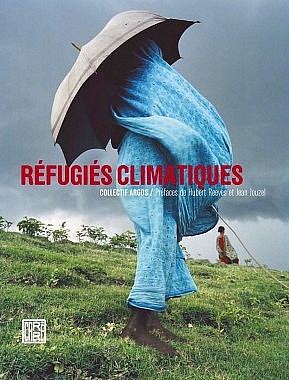-
Background
From Climate Refugees to Footprint
The human element is always at the heart of reportages produced by the photography collective Argos. This is why, in 2001, on discovering IPCC’s (Intergovernmental Panel on Climate Change) second assessment report, we wanted to put a human face to this issue. At the time it was presented in graph form and we looked to personify this phenomenon.
How ? By telling people’s stories. Those of the first victims of climate change who went from putting down roots to exile, from poverty to destitution. One figure in particular caught our attention : according to UN forecasts, « roughly 150 million climate refugees could be displaced by 2050 ».
Climate refugees : from Alaska to Chad, via the Maldives
Our journey started in November 2004 in Alaska, with the issue of Arctic permafrost melt, followed by Tuvalu, the Maldives and Halligen (Germany) to bear witness to rising sea levels ; via Chad and China where desertification was spreading ; Bangladesh experiencing delta flooding ; Nepal, victim of accelerating glacier melt ; and finally, in 2009, the United States where cyclones were becoming more and more intense. Nine states throughout the world to show that climate change is a reality and already underway. To also raise awareness of the risk of cultural diversity loss.
Argos’ first group documentary series, entitled Réfugiés Climatiques appeared many times in the French and foreign media and was published in book form (Editions Carré, 2010). The English version, Climate Refugees, was published by MIT Press and an exhibition was held during the United Nations Climate Change Conference, COP15, in Copenhagen in 2009.

Climate Refugees cover (Carré edition, 2010)
Today, an unquestionable conclusion
According to Jean Jouzel, Head of Research at the CEA (French nuclear public organisation) and Vice-President of the IPCC’s scientific panel from 2001 to 2015 (which jointly received the Nobel Peace Prize in 2007), and who wrote the preface to our book, the conclusion is unquestionable : « even though it is too late to prevent global warming as a result of our past emissions, we can limit the damage. By remaining below a 2°C increase, we will be able to adapt where the vital things are concerned. But we have to take action as of today ». According to the climatologist, the « emitter » scenario in IPCC’s 5th report, (i.e. if we do nothing to limit our greenhouse gas emissions) will lead us to an average increase in global warming close to 4°C by the end of the century.
Adapting will become very difficult, and, in any case, extremely costly. In this scenario, all the warning signs are red : not only will hundreds of millions of people have to leave their homes, particularly due to rising sea levels (almost a meter), the intensifying of extreme weather events (flooding, drought, heatwaves, cyclones), or permafrost and glacier melt, but we will also have to cope with the acidification of the ocean and coral reefs being put at risk (which are the basis of our food chain) ; with difficult access to water in some parts of the world, leading to insecurity ; with an increased loss of biodiversity and the impossibility of some natural eco-systems to adapt to such rapid change ; with the stagnation of agricultural production as well as urban pollution that is hard to deal with and affects health.